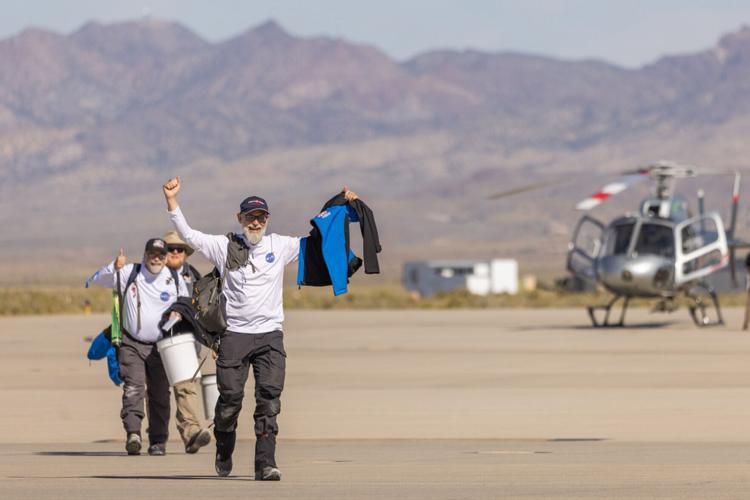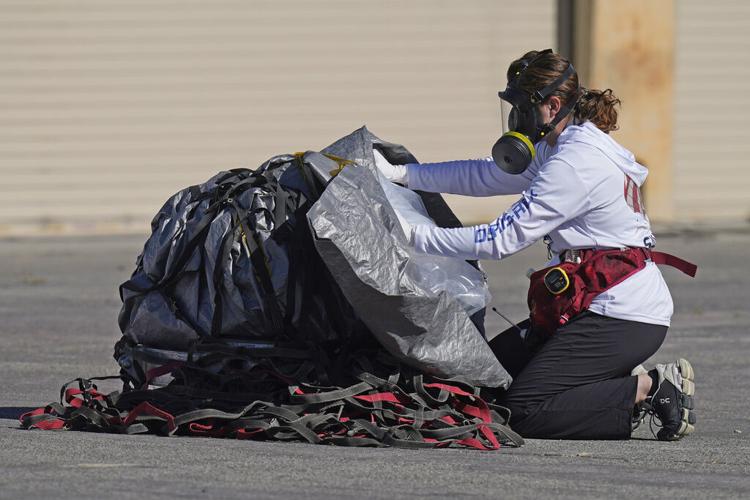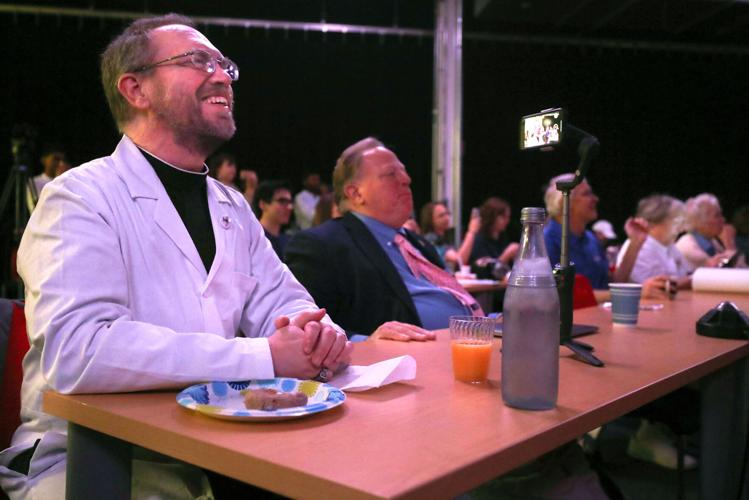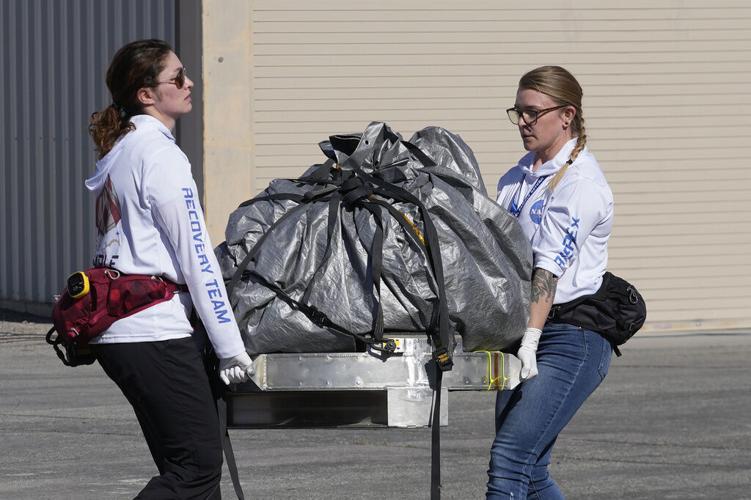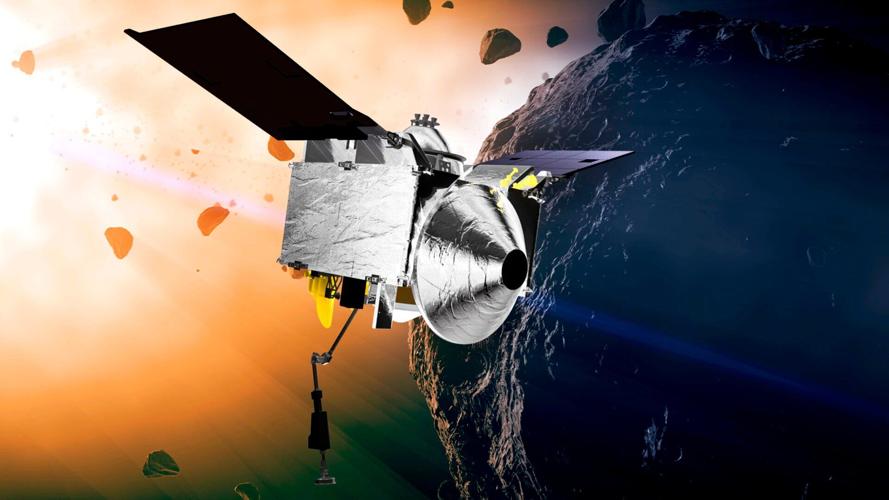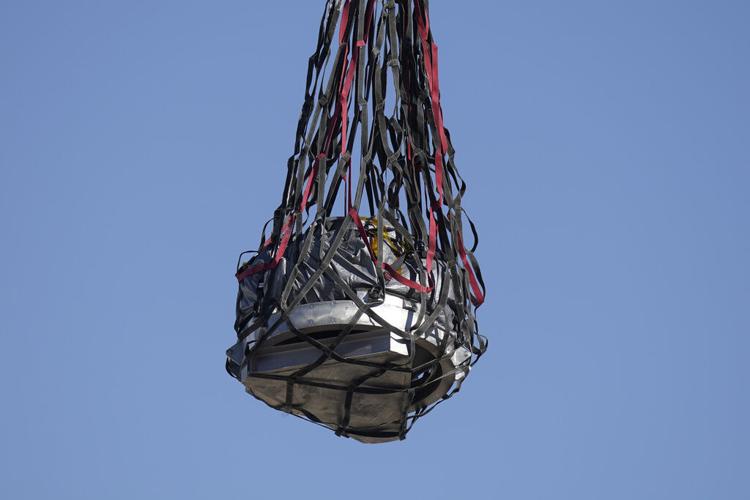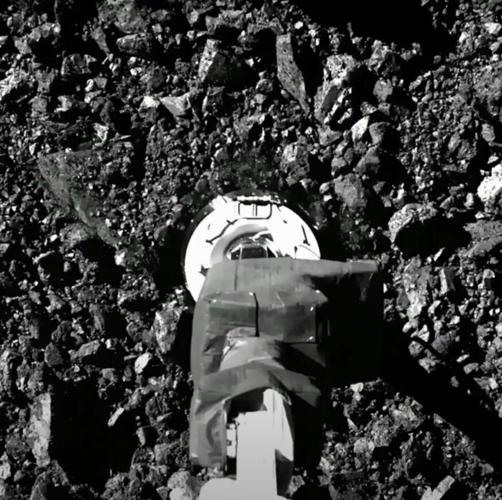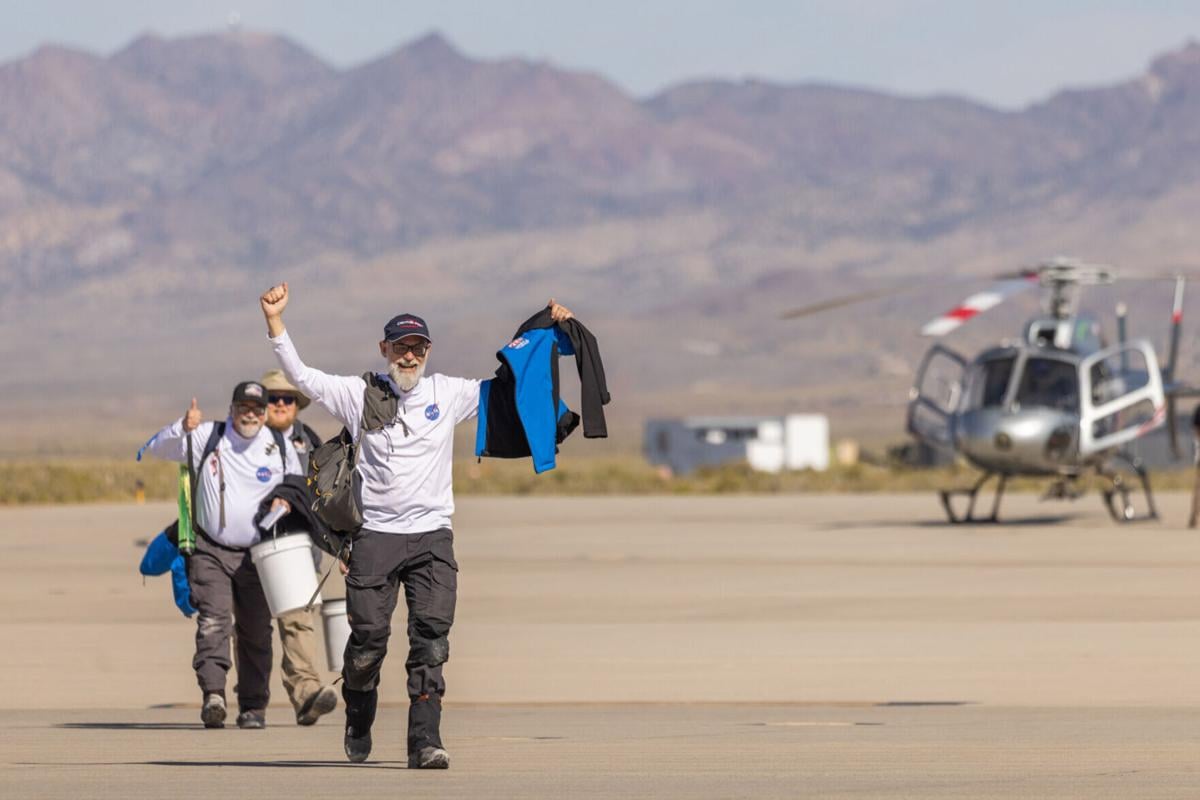DUGWAY PROVING GROUND, Utah — A cupful of rubble from the construction of the solar system is now in the eager arms of scientists.
A capsule filled with rocks and dust from the asteroid Bennu dropped into Utah’s western desert at 7:52 a.m. Tucson time on Sunday, as the University of Arizona-led, $1.1 billion OSIRIS-REx space mission reached a dramatic but flawless conclusion.
A recovery team, including OSIRIS-REx principal investigator and UA Regents’ Professor Dante Lauretta, rushed to the landing site on the Utah Test and Training Range in helicopters to secure the capsule and bring it back to a sterile clean room set up for the occasion at this secure military installation west of Salt Lake City.
“I cried like a baby in the helicopter when I heard that the parachute opened and we were coming in for a soft landing,” said Lauretta after landing to applause back at the staging area. “It was just an overwhelming moment for me.”
Inside the capsule is a science canister filled with material that could offer clues about the origins of the solar system and life on Earth.
Researchers aren’t expecting anything alive in the samples, but they do hope to find pristine, 4.5 billion-year-old material containing amino acids and other organic molecules — so-called “seeds of life” that scientists theorize were delivered to the young Earth by meteorites.

A helicopter delivers the space capsule carrying NASA's first asteroid samples to a temporary clean room at a Utah military facility Sunday. The OSIRIS-REx spacecraft released the capsule after a seven-year journey to asteroid Bennu and back.
Though just enough to fill an 8-ounce coffee cup, the OSIRIS-REx payload represents the largest amount of material brought back from space since Apollo 17 returned from the moon in 1972.
The Japan Aerospace Exploration Agency has conducted the only other successful asteroid-sampling missions so far. Its Hayabusa spacecraft collected less than a milligram of dust grains from asteroid Itokawa in 2010, and Hayabusa2 returned with just over 5 grams of dirt from asteroid Ryugu in 2020.
At about 250 grams, the OSIRIS-REx sample is believed to be about 50 times larger.

A recovery team member examines a capsule containing NASA’s first asteroid samples before it is taken to a temporary clean room at Dugway Proving Ground in Utah on Sunday.
The capsule won’t be opened until it is flown to Houston Monday on a military cargo plane and delivered to a special curation facility at NASA’s Johnson Space Center in Houston, where the science canister inside will be painstakingly emptied and its contents cataloged. That’s when scientists will find out exactly how much of Bennu they brought back.

Recovery team members carry a capsule containing NASA's first asteroid samples to a temporary clean room at Dugway Proving Ground in Utah. "Your package has been delivered," NASA tweeted.
Mission requirements called for the spacecraft to come home with at least 60 grams of asteroid regolith. A NASA official in Utah said they probably won’t know the exact size of the sample until later this week.
To keep the material safe from earthly contamination until then, it will be pumped full of nitrogen gas, forming a dry, protective atmospheric “purge” that will be maintained throughout its processing and storage.
The prize arrives a bit early
Lauretta didn’t get much sleep before Sunday’s landing. He said he tossed and turned for a while, then “got up and graded student essays” to pass the time.
Sunday’s priceless delivery from space actually arrived a few minutes early.

From left, Francis McCubbin and Scott Sandford, both of NASA, and the University of Arizona’s Dante Lauretta collect data next to the OSIRIS-REx sample return capsule after it landed in Utah on Sept. 24.
At 7:42 a.m. Tucson time, the capsule, about the size of a truck tire, hit the atmosphere above the California coast at about 27,000 mph and quickly heated up to about 5,000 degrees Fahrenheit.
The main parachute deployed a few minutes later, prompting a cheer from the crowd of officials gathered in Utah to watch the landing.
The prize from NASA’s first asteroid sampling mission landed intact about 10 minutes after entering the atmosphere, three minutes sooner than expected.
The drama unfolded at the Utah Test and Training Range, a secure U.S. Air Force reserve covering 2,675 square miles on both sides of Interstate 80 west of the Great Salt Lake.
Nearby Dugway Proving Ground, once a secret site for chemical and biological weapons testing, served as a staging area for the recovery operation. The helicopters and temporary clean room were housed at Michael Army Airfield, inside the proving ground.
Tucson-born mission
The successful recovery capped an effort that began in Tucson about 20 years ago, back when Bennu was known only as asteroid 1999 RQ36.
A UA team led by Regents Professor Michael Drake, director of the Lunar and Planetary Laboratory, initially applied for funding through NASA’s Discovery program in 2004, but the proposal failed to make the cut three years later.
Drake and company tried again under the New Frontiers program, and NASA selected the mission in May 2011.
At the time, Drake called it the largest research project the university had ever seen, and he described OSIRIS-REx as an exploration of humanity’s origin and its destiny.
“The origin is, ‘Where did the organics come from that led to us?’ The destiny is, ‘Will we go the way of the dinosaurs?’” he said.

Brother Robert Macke smiles as he watches the OSIRIS-REx capsule begin its Utah landing during a watch party Sunday at the University of Arizona's Michael J. Drake Building, 1415 N. Sixth Ave. in Tucson. Macke said he's an operator of a picometer for measuring density osmosis for the asteroid mission.
Drake died on Sept. 21, 2011, after a long illness, leaving Lauretta to assume command of the mission from his long-time mentor and friend.
The robotic spacecraft was launched in September 2016 and arrived at Bennu in December 2018.
On Oct. 20, 2020, OSIRIS-REx swooped in to touch the asteroid’s surface for about six seconds — just long enough to scoop up a cloud of pebbles and dust.
It left Bennu for good in May 2021, after also collecting enough data about the asteroid's composition and orbit to precisely predict its odds of hitting the Earth some day. (Scientists now give the cosmic rock pile roughly the size of Pusch Ridge in the Catalina Mountains a 1 in 2,700 chance of impacting our planet on Sept. 24, 2182.)
The spacecraft has now traveled almost 4 billion miles to Bennu and back on a circuitous route around the sun between the orbits of Earth and Mars.
‘We’re finally here for real’
Anjani Polit was the only other member of the UA’s mission team who traveled to Utah for the landing.
“It’s hard to believe we’re finally here for real,” she said as she watched the recovery helicopters lift off to head out to the 250-square-mile landing zone.
Polit has worked on OSIRIS-REx for the past seven years. As mission implementation systems engineer, her job now inovles helping to coordinate the analysis team of about 200 researchers around the world who will spend the next two years performing the first in-depth science work on the samples.

The University of Arizona's Dante Lauretta, the principal investigator for OSIRIS-REx, talks to reporters after the successful recovery in Utah of the space capsule containing asteroid samples. "I cried like a baby," a relieved Lauretta said.
She said the team should begin receiving bits of Bennu in a month or two.
Both Polit and Lauretta are scheduled to fly with the canister to Houston on a C-17 transport plane on Monday morning.
World-class lab at UA
Meanwhile at the UA, a suite of electron microscopes and other sophisticated instruments waits at the Kuiper Space Sciences Building to start examining the asteroid grains down to the atomic level. Researchers have spent the past decade or so assembling a world-class laboratory complex in the building’s basement, expressly to support OSIRIS-REx.
The Kuiper Materials Imaging and Characterization Facility can take a single speck of dust, one fifth the width of a human hair, and carve it into hundreds of slices for individual study.
The director of the facility, UA professor Thomas Zega, is part of NASA’s “quick-look team” assigned to conduct the first science on the material brought back from Bennu.
He and the rest of the team, which includes UA assistant professor Pierre Haenecour, will work out of the sterile curation facility at Johnson Space Center.
The quick-look team will perform an initial characterization of the material using dust that stuck to the outside of the spacecraft’s sampling device when it touched down on the asteroid.

This illustration depicts the OSIRIS-REx spacecraft at the asteroid Bennu.
Zega and Haenecour plan to bring some of that early sample back to Tucson with them once their work in Houston is done.
Eventually, those first bits of Bennu will be joined at the Kuiper building someday by a much larger share of the precious payload.
Scientists near and far
Over the next two years, about one-quarter of the material recovered Sunday will be doled out for study by scientists around the world, and a sizable amount is expected to land at the UA.
The remaining three-quarters of the haul from NASA’s first asteroid sampling mission will be set aside by the space agency for future research, much the way moon rocks collected during the Apollo missions are still being analyzed today.
“Future scientists who might be in elementary school right now could be studying these samples some day,” Polit said.
The OSIRIS-REx spacecraft released the sample-return capsule at 3:42 a.m. Tucson time, sending it on a solo journey toward the atmosphere that lasted four hours.
The probe, the size of a passenger van, was then steered away from Earth to begin its next adventure: a rendezvous with the asteroid Apophis in 2029.

The spacecraft touches the surface of asteroid Bennu on Oct. 20, 2020.
That mission, called OSIRIS-APEX, is being led by UA assistant professor Dani DellaGiustina, who headed up the OSIRIS-REx imaging team and then served as its deputy principal investigator.
DellaGiustina observed the end of one mission and the beginning of the next from the flight operations center at Lockheed Martin Space outside of Denver, where the spacecraft was built.
Mission team members not directly involved in the recovery operation watched NASA’s live broadcast from the UA’s Drake Building, which is named after the man who gave OSIRIS-REx its start.
Members of the University of Arizona-led OSIRIS-REx mission team watched Sunday morning's events from the Michael J. Drake Building as samples taken from an asteroid landed in Utah following a seven-year journey.
Interest in Sunday’s event extended far beyond the scientific community. NASA officials said 60 different media outlets were on site to cover the landing, including journalists from Japan, Britain and Canada.The space agency broadcast the landing live in English and Spanish on its TV channel and across social media.
Sir Brian May, the world-famous Queen guitarist and Ph.D. astrophysicist, celebrated the capsule return in a video he recorded for the broadcast. In it, he shouted out his “dear friend Dante” Lauretta, with whom he co-authored a 3D atlas of Bennu that was published in July.
On Friday, the U.S. Postal Service held a first-day-of-issue ceremony in Salt Lake City for the new “OSIRIS-REx Return to Earth” postage stamp, which depicts the sample-return capsule descending under a parachute over the Utah desert.
On Tuesday, the Pima County Board of Supervisors and the Tucson City Council declared Sept. 24 as “OSIRIS-REx Sample Return Mission Day” with a proclamation recognizing the UA’s achievement and its out-sized role in space exploration and the community.
A number of UA officials traveled to Utah to witness the historic landing, including university President Robert Robbins.
Even a former UA administrator made the trip, albeit from a shorter distance.
Elizabeth “Betsy” Cantwell spent four years as senior vice president for research and innovation at Arizona before leaving in May to become president of Utah State University in Logan, about 160 miles northeast of Dugway Proving Ground.
She said Utah State designed an instrument for OSIRIS-REx, but a “space engineer by training” like her wasn’t going to miss the landing regardless, especially after watching the mission’s earlier achievements from Tucson.
“The coolest thing isn’t where we are now, it’s when the science comes out,” Cantwell said from the tarmac at Michael Army Airfield, as the helicopters began to return from the landing zone. “That science — and I think we’ll see the papers start to come out pretty quickly — is going to be amazing, just amazing.”


